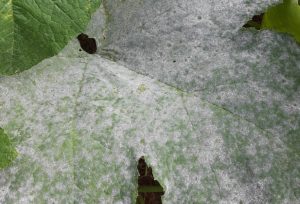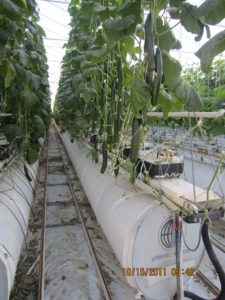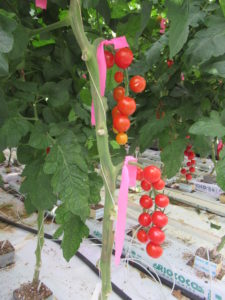IR-4 works with growers and Canadian PMC to secure new Pyriofenone uses
Powdery mildew is a major fungal disease impacting greenhouse vegetables, including cucumbers, tomatoes, eggplant and peppers. Fruit yield losses can reach as much as 20 percent for cucumber growers. Although several species of powdery mildew affect fruiting greenhouse vegetables, Leveillula taurica is particularly difficult to control.
As a result of joint efforts by The IR-4 Project (IR-4) and the Canadian Pest Management Centre (PMC), the Environmental Protection Agency (EPA) published a final rule on July 5, 2022, approving new tolerances to allow for use of Pyriofenone on greenhouse tomatoes, peppers and eggplant. By virtue of this IR-4 submission, greenhouse growers will have an approved use on cucumbers once the new label is published.
Advocating for greenhouse growers

Photo courtesy of University of Maryland Cooperative Extension.
Since the greenhouse vegetable industry is small in acreage size compared to other field crops like corn and soybeans, pest management products are often less accessible. IR-4 and PMC both help identify safe, effective pest control products for use on specialty crops, making them key allies of greenhouse vegetable producers throughout North America.
Michael Bledsoe, Vice President of Food Safety and Regulatory Affairs at Village Farms International, works with greenhouse vegetable growers in the United States and Canada to identify diseases and insects that can cause major problems with these crops and potential pest management tools that could gain label registration.
“For the last 15 years, there has been a team of greenhouse growers in the U.S. and Canada that is interested in gaining product registrations,” said Bledsoe. “Ultimately, researchers were able to discover that the fungicide Pyriofenone controls this powdery mildew species.”
Bledsoe stated that, because of persistent fungal issues in greenhouse production, growers in the U.S. approached IR-4 for assistance with registration of this fungicide on tomatoes, cucumbers, peppers and eggplant. Pyriofenone has proven effective on other powdery mildew species, including Oidium neolycopersici on tomatoes and some other species that infect cucumbers. Pyriofenone can be used in rotation with other fungicides, but there are no others as effective at controlling the Leveillula species, so growers were keen to see this registration approved.
Taking a page from IR-4
Canada’s PMC was established in 2003 as a division of Agriculture & Agri-Food Canada (their federal department of agriculture). PMC was based on the IR-4 model, working with the public and private sectors to help facilitate registration of pest management products for use on specialty crops. PMC came about because Canadian specialty crop growers wanted the same access to chemical control products that U.S. growers had.

Photo courtesy of Village Farms International.
“The growers have control in Canada,” said Jennifer Ballantine, PMC’s acting Executive Director. “The growers identify what their top priorities are regarding pests and diseases for particular crops. At the annual PMC workshop, all the stakeholders are there, including grower groups, provincial representatives, chemical company representatives, and officials from Health Canada.”
Ballantine explained that the PMC modeled its annual priority setting process after IR-4’s Food Use Workshop. Through this process, Pyriofenone was selected as a research priority, and became a joint project between IR-4 and PMC with the goal of sharing data and securing labels in both the U.S. and Canada.
A team effort to gain Pyriofenone label
IR-4 and PMC conduct some joint product registration studies, representing about 25 percent of PMC’s projects. For most joint projects, either IR-4 or PMC is the lead, with trials conducted in both countries. For Pyriofenone, projects were prioritized by stakeholders, and studies were conducted to support registration, in different years.
“Normally when we do a joint project, if it’s a priority in both countries in the same year, because of efficiency, the projects start at the same time,” Ballantine said. “In the case of Pyriofenone, prioritization came up in different years. Greenhouse cucumbers were the first crop for which IR-4 started Pyriofenone studies. The greenhouse pepper and tomato studies were conducted in Canada. We shared the study results and submitted the reports jointly.”
In the case of greenhouse studies, it is acceptable to the regulatory agencies for IR-4 and PMC to share data with each other due to the tightly controlled environment. The Pyriofenone study results were submitted at the same time to EPA in the U.S. and to the Pest Management Regulatory Agency (PMRA), which is a division of Health Canada. EPA and Health Canada work together and share their evaluations (a joint review), which saves time and work for the two agencies.
Choosing safer, more effective products
Bledsoe noted that several safety criteria have to be met for growers to pursue a label with IR-4 and PMC, especially in greenhouse production.

Photo courtesy of the Pest Management Centre.
“The product has to be efficacious and work against the pest or pathogen,” Bledsoe said. “It also has to have a short pre-harvest interval (PHI) and short re-entry interval (REI). A short REI is particularly important because these crops are harvested every day. In a greenhouse, it is also vital to study the product across multiple crops due to the close proximity to one another (there could be tomatoes, peppers, cucumbers, and eggplants). We look for products that will work on multiple crops simply because of the potential for exposure to other crops.”
Another criterion for acceptable chemical controls in greenhouse systems is the protection of beneficials, including bumble bees, predacious mites, predatory wasps, and other biological controls.
“Biologicals and beneficials are a major part of our integrated pest management program,” Bledsoe said. “All of the chemical controls we consider for applying for label registration, we
screen for their safety to beneficials. Biologicals are a critical part of most greenhouse vegetable growers’ IPM programs because they work 24 hours a day.”
Continued collaboration for specialty crop success
Joint efforts like this one by IR-4, PMC and EPA provide a roadmap for continued successes on behalf of specialty crop growers. Safe, effective pest management products help controlled environment growers and farmers thrive, and help consumers enjoy a healthy and abundant food supply. Visit the IR-4 website to learn more about the Pyriofenone tolerance and other successes.
Editor’s notes:
-In Canada, Pyriofenone fungicide is marketed as Property 300SC.
-David Kuack is a freelance technical writer in Fort Worth, Texas; dkuack@gmail.com.
-Van Starner is Senior Management Associate at The IR-4 Project; vrstarne@ncsu.edu.
About The IR-4 Project
The mission of the IR-4 Project is to facilitate regulatory approval of sustainable pest management technologies for specialty crops and specialty uses to promote public well-being. By working directly with local crop growers across the country, IR-4 conducts research and develops data necessary for the registration of pest management tools, ensuring that they are safe for use. To learn more, visit our website.[/vc_column_text][/vc_column][/vc_row]
